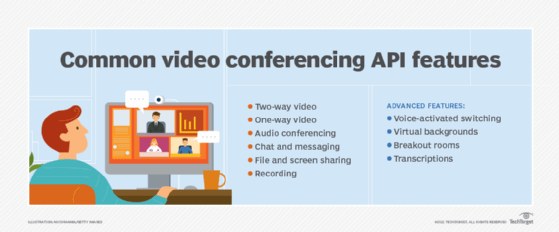Popular video conferencing APIs to weigh for app integration
Video conferencing APIs can simplify integrating video with business applications. Learn the benefits of video APIs and best practices to follow when evaluating API providers.
Video has become an essential part of our lives over the last year. It is no longer just an alternative to travel; for many, it is now a key element of business processes. As a result, video is now an expected feature for many business apps.
Unfortunately, for business app developers, video conferencing technology is not easy. Writing code from scratch to add video capabilities to your app is a herculean task, and the results are often disappointing. It took decades for the video conferencing industry to develop today's reliable, high-quality video protocols. You might have a talented coding team, but it won't be able to recreate in a few months the same kind of video experience that we now expect. This is where video conferencing APIs can save the day.
What are video conferencing APIs and why use them?
APIs are a way of offloading some of the work your app does to another service. One obvious example is Uber using the Google Maps API. As successful as Uber is, it just doesn't make sense for the company to spend hundreds of millions of dollars to create its own version of Google Maps. Even so, it wouldn't be as good as Google Maps because it wouldn't have the traffic data from the millions of Google Maps users. So, instead, Uber uses the Google Maps API. The work is being done on Google's servers -- the API is just a connection between the two services.
That's the beauty of a video API. You don't need to invest significant time and money to develop the video code, but you also don't have to manage, host and route the video. Hosting video internally adds to the complexity and cost of development for an app, as well as to ongoing management costs.
This article is part of
The enterprise guide to video conferencing
When you use an API, all the video-related work is done on the API provider's servers. Your app -- and your servers -- can focus on the actual main purpose of the app, while all the heavy lifting for video is handled by the API provider. It is the digital equivalent of outsourcing to an expert. By using a video conferencing API, you can achieve the following benefits:
- Faster development time. Your coding team may be aces, but it will take them some time to create their own homegrown video capabilities for your app. APIs are built off the decades of video technology development.
- Cost savings. Hosting and managing video traffic are not trivial. Offloading traffic through an API can greatly reduce infrastructure costs.
- Updated features. API providers are constantly adding new features and capabilities. If you use their APIs, you get to use these new features without having to develop them internally.
Popular video conferencing APIs
There are plenty of providers of video APIs. The list of vendors who specialize in APIs is long but includes the following names:
- CometChat
- Eyeson
- MirrorFly
- PubNub
- QuickBlox
- Sinch
- Twilio
- Vidyo
- Vonage
- Voxeet
Traditional video conferencing providers, such as Zoom, BlueJeans, Pexip and Cisco, also offer APIs based on their services. If you choose a traditional video conferencing provider, you will know exactly what to expect in terms of quality and reliability, but a company focused on APIs may offer more options or customization.
One of the biggest benefits of using a video conferencing API is that you don't need to deploy a full suite of video capabilities, but rather pick and choose which features to implement. You can just add the ones that you need to support your customers. The features available in a video API are typically those found in a video conferencing app, including the following:
- Two-way video. The core of video chat is enabling remote people to meet face to face. A video API can add the ability for business apps to send, receive and display video on end-user devices.
- One-way video. If an app's use case requires video to only go in one direction, an API can offer a simpler deployment -- no need to overly complicate things by adding bidirectional video if it isn't needed.
- Audio conferencing. Video may not always be needed for some use cases, such as using an app while driving. In those cases, a video API can be used to add audio conferencing alone.
- Chat and messaging. Chat is an essential element for many types of apps. A video API can provide chat functionality in a way that supports the app's workflow.
- File and screen sharing. If an app is designed to support any type of collaboration, these tools can be a game changer when collaborating over video.
- Recording. This is often a highly requested feature for apps with any video component, particularly those that must comply with any compliance or retention policies.
- Advanced features. Just about any feature you can find in a video app is also available in an API. If your favorite video app has a feature you like, whether it be voice-activated switching, virtual backgrounds, breakout rooms or transcriptions, don't be afraid to ask if it is available via an API.

Best practices for integrating a video conferencing API
When choosing an API provider, you will want to consider the following factors:
- Customization. Adding video to an app should complement and support the app's existing functionality. Video should feel like a natural part of the experience, rather than a bolt-on addition. Be sure you can customize an API in the ways that will matter to your users and customers.
- General capabilities. Different video APIs offer different feature sets. For example, if it makes sense for users to access multiple cameras in your app, be sure the API supports multiple camera setups.
- Video quality. While video quality has improved over decades of development, not all video is the same. Video providers use different approaches, code and technology to support their API services. Some may offer higher-resolution video, more advanced audio features like noise reduction, or a more reliable and consistent experience than other providers. When evaluating API providers, do quality testing to determine if the API meets your requirements.
- Pricing. Video APIs are generally priced per participant minute. This is calculated by totaling the minutes of each participant in a video session and multiplying the total by the price per participant minute set by the provider.
But pricing models can vary, with some services including a bundle of minutes. Some providers may offer discounts for larger bundles. Depending upon how you plan to use video, the pricing model of a video API can significantly affect your total costs.
The actual implementation of an API generally requires the use of an SDK from the provider. SDKs enable development teams to add the code to your app to access the video conferencing API. Video should be integrated into the app in a way that feels seamless and intuitive for users. They shouldn't feel like they are leaving the app to join a video meeting.
We still have a lot to learn about what is in store for us in the post-pandemic world. But one thing is for certain: It is a video-first culture. Video is no longer an extra feature in an app; it is part of user expectations. Offloading the heavy burden of video with an API can be a quick and affordable way to meet those expectations.







